The Eastern Red-tailed Hawk (Buteo jamaicensis borealis) is a majestic bird of prey, commanding attention with its striking appearance and formidable aerial prowess.
Widely distributed across eastern North America, from southern Canada to the Gulf of Mexico, this raptor inhabits a diverse range of environments, showcasing its adaptability.
Known for its characteristic brick-red tail, the Eastern Red-tailed Hawk boasts a robust build, a sharp hooked beak, and keen eyesight, making it an efficient hunter.
Its distinctive cry resonates across open country, woodlands, and even urban landscapes, marking its presence in the avian tapestry.
With a rich life history, captivating behaviors, and cultural significance, the Eastern Red-tailed Hawk stands as an iconic symbol of the natural world, embodying both the strength and grace of the avian kingdom. So, stay focused.
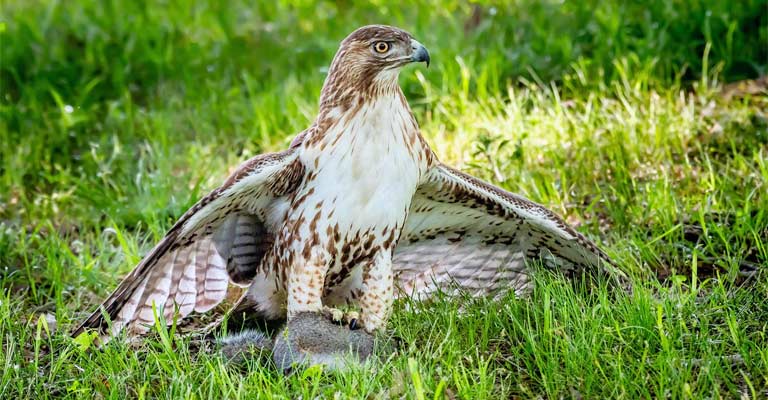
Taxonomy of Eastern Red-tailed Hawk
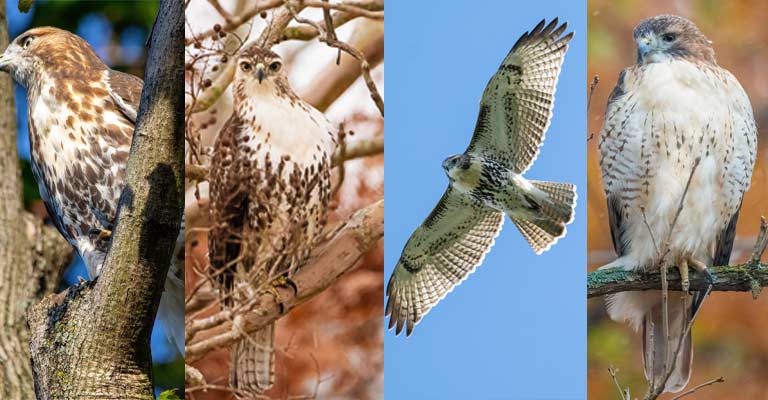
Here’s a table outlining the taxonomy details of the Eastern Red-tailed Hawk:
| Taxonomic Level | Classification |
| Domain | Eukaryota |
| Kingdom | Animalia |
| Phylum | Chordata |
| Class | Aves |
| Order | Accipitriformes |
| Family | Accipitridae |
| Genus | Buteo |
| Species | B. jamaicensis |
| Subspecies | B. j. borealis |
This taxonomy table provides a hierarchical overview of the Eastern Red-tailed Hawk’s classification, from the broad domain level down to the specific subspecies.
It helps contextualize the bird within the larger framework of the animal kingdom and highlights its evolutionary relationships.
The Eastern Red-tailed Hawk, scientifically classified as Buteo jamaicensis borealis, belongs to the Animalia kingdom, Chordata phylum, and Aves class.
It is further categorized under the Accipitriformes order and Accipitridae family.
Within the Accipitridae family, it falls under the Buteo genus. The specific epithet, B. jamaicensis, denotes its species, and the subspecies B. j. borealis specifies its regional variation.
This raptor’s taxonomy reflects its avian lineage, grouping it with other hawks and eagles while highlighting its unique characteristics within the expansive diversity of the animal kingdom.
Physical Characteristics of Eastern Red-tailed Hawk
The Eastern Red-tailed Hawk (Buteo jamaicensis borealis) is a magnificent raptor that inhabits a diverse range of environments across eastern North America.
Identifying this specific bird requires a keen eye and attention to its distinct physical characteristics. Here are eight key points to help you identify the Eastern Red-tailed Hawk:
Size and Shape
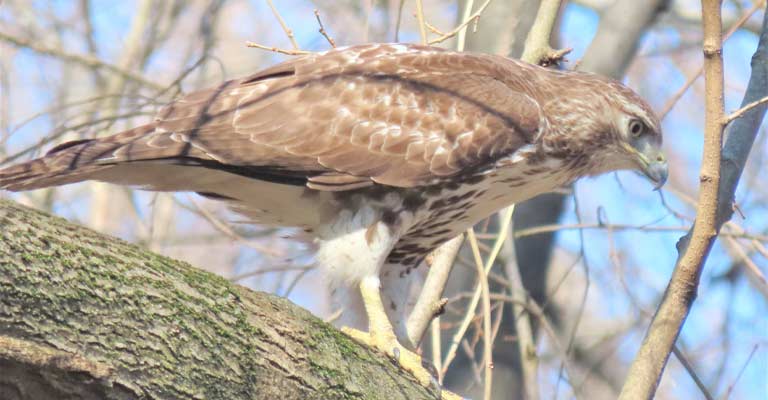
The Eastern Red-tailed Hawk is a large bird of prey with a wingspan ranging from 45 to 56 inches. Its body length measures between 18 to 26 inches.
The wings are broad and rounded, providing excellent soaring capabilities. The bird exhibits a robust build, particularly noticeable when observed in flight.
Coloration
Adult Eastern Red-tailed Hawks showcase a striking combination of colors. The upperparts are dark brown, while the underparts, including the belly and chest, are typically lighter with a mottled appearance.
The most distinctive feature is the brick-red tail, which contrasts sharply with the rest of the body.
Head and Facial Features
The head of the Eastern Red-tailed Hawk is broad, and it features a dark “comma” or “belly band” on the lower part of its throat.
The facial disc, a distinctive feature in many raptors, is not as prominent in this species. The cere (the fleshy area at the base of the beak) is usually yellow.
Eyes

The eyes of the Eastern Red-tailed Hawk are large and striking. They are typically yellow or yellowish-orange in color.
This vibrant eye color is a significant characteristic, especially when observing the bird up close.
Bill and Talons
The beak of the Eastern Red-tailed Hawk is sharply hooked, a feature common among raptors for tearing into prey.
The talons are robust and well-adapted for grasping and capturing prey. These powerful features aid in the bird’s hunting prowess.
Juvenile Plumage
Juvenile Eastern Red-tailed Hawks have a different appearance than adults. They often exhibit a more mottled and streaked overall appearance.
The red tail, a defining characteristic of adults, may not be fully developed in juveniles, and their eyes might be a lighter color, gradually changing to yellow as they mature.
Flight Pattern
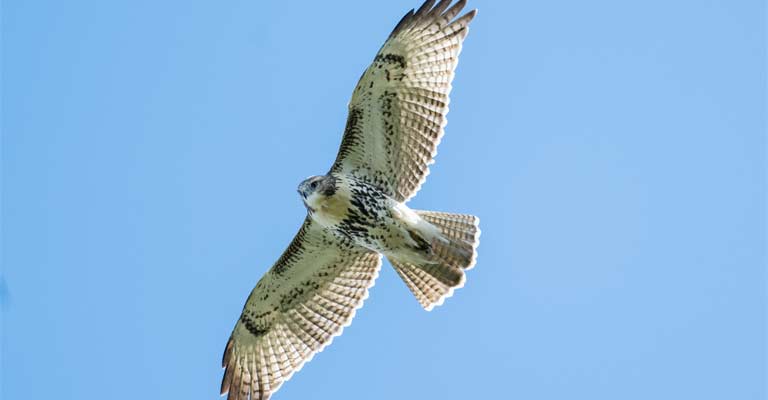
When in flight, the Eastern Red-tailed Hawk soars with its wings held in a slight dihedral (V-shape).
The broad wings, coupled with a distinctive tail, make for a recognizable silhouette. During flight, the red tail is highly visible, aiding in identification.
Habitat and Geographic Range
The Eastern Red-tailed Hawk is adaptable and can be found in a variety of habitats, including open country, woodlands, and even urban areas.
Its range covers eastern North America, from southern Canada to the Gulf of Mexico. Observing the bird in its natural habitat can provide valuable context for identification.
Identifying the Eastern Red-tailed Hawk involves a combination of observing its size, coloration, distinctive markings, and behavioral traits.
Whether soaring in the sky or perched in a tree, the unique features of this raptor make it an exciting species to encounter in the wild.
Eastern Red-tailed Hawk Life History
The Eastern Red-tailed Hawk (Buteo jamaicensis borealis) is a captivating bird of prey with a rich and diverse life history.
From its choice of habitat to nesting behaviors, breeding habits, and conservation concerns, each aspect contributes to the intricate tapestry of the Eastern Red-tailed Hawk’s existence.
Food
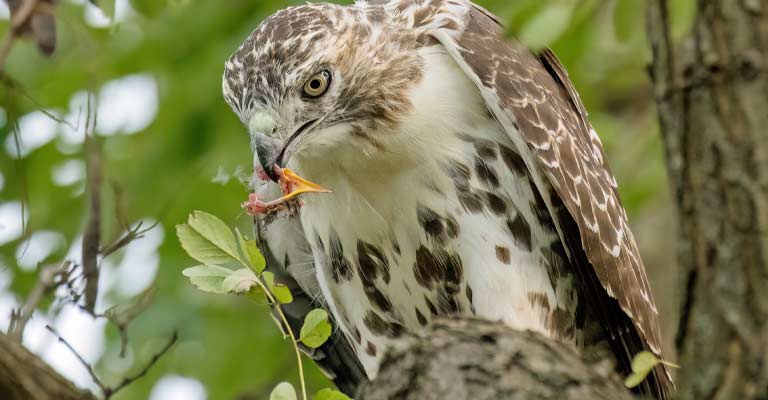
The Eastern Red-tailed Hawk is a formidable predator, preying on a wide variety of small to medium-sized mammals. Its diet includes rodents, rabbits, squirrels, and occasionally birds.
The hawk’s keen eyesight enables it to spot potential prey from great heights, and its powerful talons and hooked beak are well-adapted for capturing and consuming its quarry.
Habitat
This adaptable raptor is found in diverse habitats, ranging from open country and grasslands to woodlands and urban areas. The key factor in its habitat selection is the availability of suitable prey.
Eastern Red-tailed Hawks are often seen perched on fence posts, telephone poles, or in tall trees, using these vantage points to scan for potential prey.
Range Map
The Eastern Red-tailed Hawk’s range extends across eastern North America, encompassing a vast territory from southern Canada to the Gulf of Mexico.
The bird is a year-round resident in many parts of its range, while individuals in northern areas may migrate south during the winter months in search of more abundant food sources.
Nesting
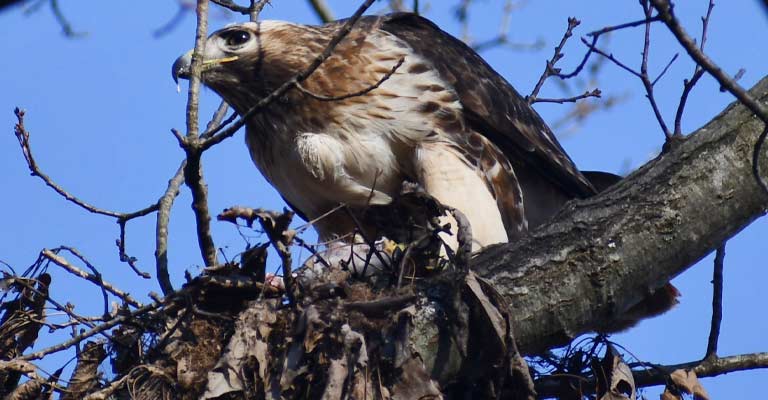
These hawks are known for their impressive nest-building skills. They construct large nests made of sticks, lined with softer materials such as bark and leaves.
Nest sites are typically found high in trees, on cliffs, or even on man-made structures like power poles. The same nest may be reused and added to in successive years.
Here’s a table outlining the nesting details for the Eastern Red-tailed Hawk:
| Nesting Details | Facts |
| Clutch Size | 1 to 5 eggs |
| Number of Broods | Usually 1 per year |
| Egg Length | Approximately 2.2 to 2.7 inches (5.6 to 6.9 cm) |
| Egg Width | Approximately 1.8 to 2.2 inches (4.6 to 5.6 cm) |
| Incubation Period | Roughly 28 to 35 days |
| Nestling Period | About 42 to 46 days |
| Egg Description | Creamy-white with blotches and speckles |
| Nest Construction | Large stick nest, lined with softer materials |
| Nest Location | High in trees, on cliffs, or man-made structures |
| Parental Care | Both parents share incubation and feeding duties |
| Fledgling Behavior | Young hawks learn to fly and hunt under parental guidance |
| Nest Reuse | Nests may be reused and added to in successive years |
These details provide insights into the reproductive behavior and nesting habits of the Eastern Red-tailed Hawk, showcasing the species’ commitment to the care and upbringing of its offspring.
Breeding
Breeding season for Eastern Red-tailed Hawks typically begins in late winter to early spring.
Courtship displays involve aerial acrobatics and calling between mates. After mating, the female lays a clutch of one to five eggs, with both parents sharing incubation duties.
The chicks hatch after about a month, and parental care continues as the young hawks fledge and learn to hunt.
Diseases
Like many birds of prey, Eastern Red-tailed Hawks are susceptible to various diseases, including avian pox and West Nile virus.
These diseases can impact the health of both adults and nestlings, potentially affecting reproductive success.
Treatment
Conservation efforts often include monitoring and addressing disease concerns. In captivity, affected birds may receive veterinary care and treatment.
In the wild, ongoing research focuses on understanding and mitigating the impact of diseases on Eastern Red-tailed Hawk populations.
Conservation
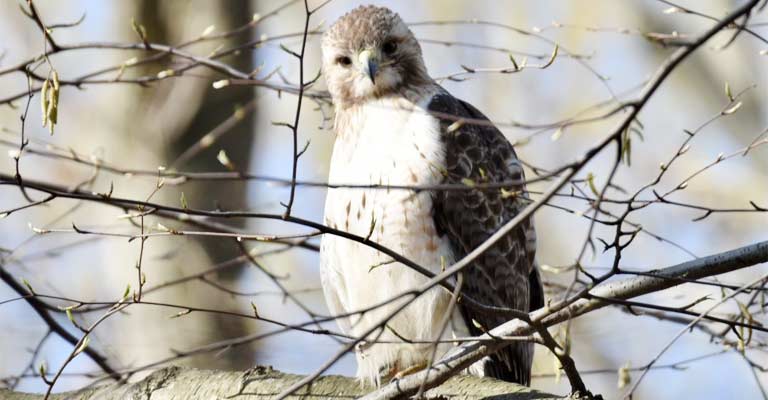
While the Eastern Red-tailed Hawk is not currently listed as a species of concern, habitat loss, pesticide exposure, and human disturbance pose ongoing threats.
Conservation efforts aim to protect suitable habitats, minimize pesticide use, and educate the public about the importance of raptors in maintaining ecosystem balance.
The life history of the Eastern Red-tailed Hawk reflects its resilience and adaptability.
From hunting strategies to nesting behaviors, understanding the various aspects of this bird’s life contributes to informed conservation and appreciation for this iconic raptor.
10 Fun Facts About Eastern Red-tailed Hawk
The Eastern Red-tailed Hawk, a majestic bird of prey, possesses a wealth of intriguing features and behaviors that make it a fascinating subject for bird enthusiasts. Here are 10 fun facts about the Eastern Red-tailed Hawk:
- Distinctive Cry: The Eastern Red-tailed Hawk is known for its distinctive, high-pitched scream, often heard in movies to depict a generic hawk sound. This call serves various purposes, including communication with its mate and establishing territory.
- Variable Coloration: While the name suggests a red tail, not all Eastern Red-tailed Hawks have this characteristic. Some individuals may have a range of colors, including pale red, cinnamon, or even dark brown tails.
- Urban Adaptability: These hawks showcase adaptability by thriving in urban environments. They can be spotted hunting in city parks, along highways, and even nesting on buildings or man-made structures.
- Longevity: In the wild, Eastern Red-tailed Hawks can live for more than a decade. The oldest known individual in captivity lived to be over 30 years old, a testament to their resilience.
- Territorial Displays: During courtship and territorial displays, Eastern Red-tailed Hawks engage in impressive aerial acrobatics. This includes soaring, diving, and loop-the-loops, showcasing their agility and strength.
- Feeding Behavior: These hawks are skilled hunters, employing a sit-and-wait strategy. They perch on elevated vantage points, patiently scanning the surroundings for potential prey before swooping down to capture it.
- Migratory Patterns: While some individuals are year-round residents, others in northern regions may migrate south during winter. This behavior is influenced by the availability of prey in their respective habitats.
- Keen Eyesight: Eastern Red-tailed Hawks possess exceptional eyesight, enabling them to spot prey from great heights. Their vision is estimated to be eight times more powerful than that of humans.
- Symbolism: The Red-tailed Hawk holds cultural significance for many Native American tribes, symbolizing vision, strength, and leadership. It is often revered as a spirit animal representing focus and determination.
- Conservation Success: With their adaptability and conservation efforts, Eastern Red-tailed Hawks have thrived in various environments. Their populations remain stable, contributing to the overall health of the ecosystems they inhabit.
The Eastern Red-tailed Hawk captivates not only with its striking appearance but also with a myriad of behaviors and adaptations that make it a truly remarkable bird in the avian kingdom.
Wrapping Up
The Eastern Red-tailed Hawk stands as a captivating symbol of nature’s prowess, embodying adaptability, resilience, and grace.
From its distinct physical features to its intricate life history and fascinating behaviors.
This raptor also commands admiration and underscores the importance of conservation efforts to ensure its continued presence in our ecosystems. Thank you for your support.
